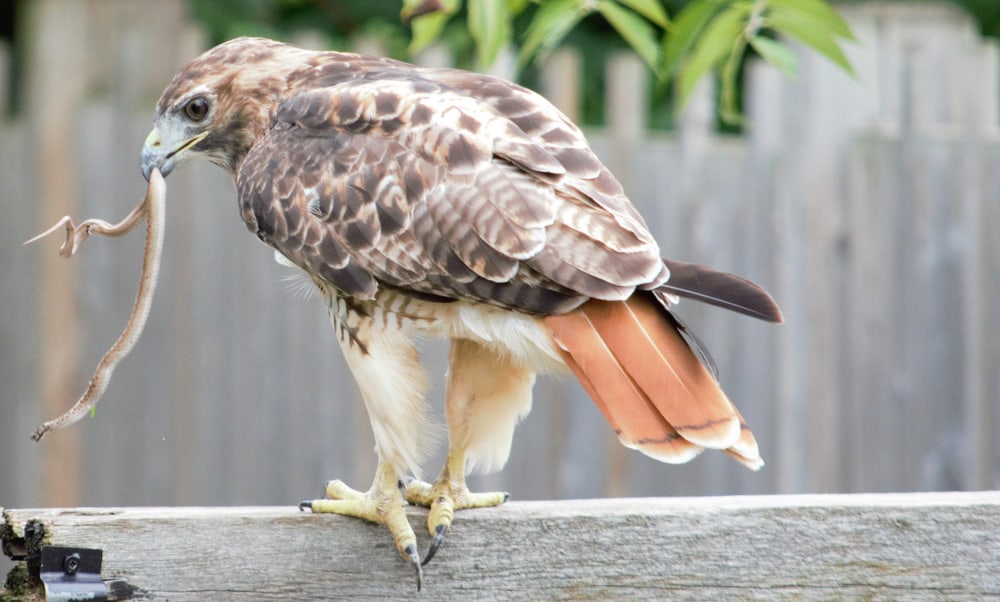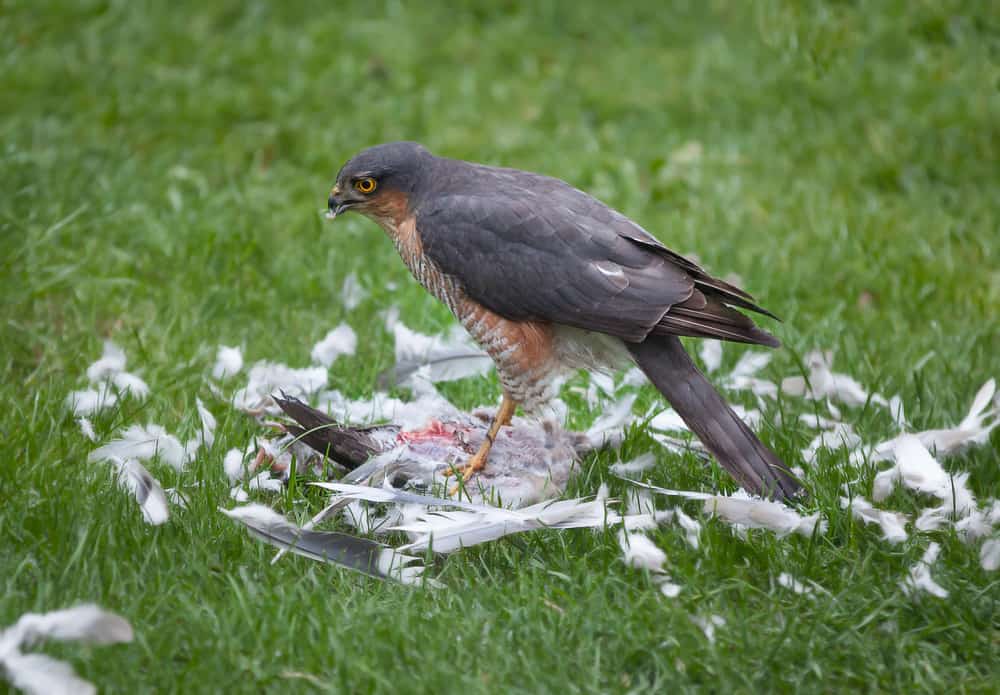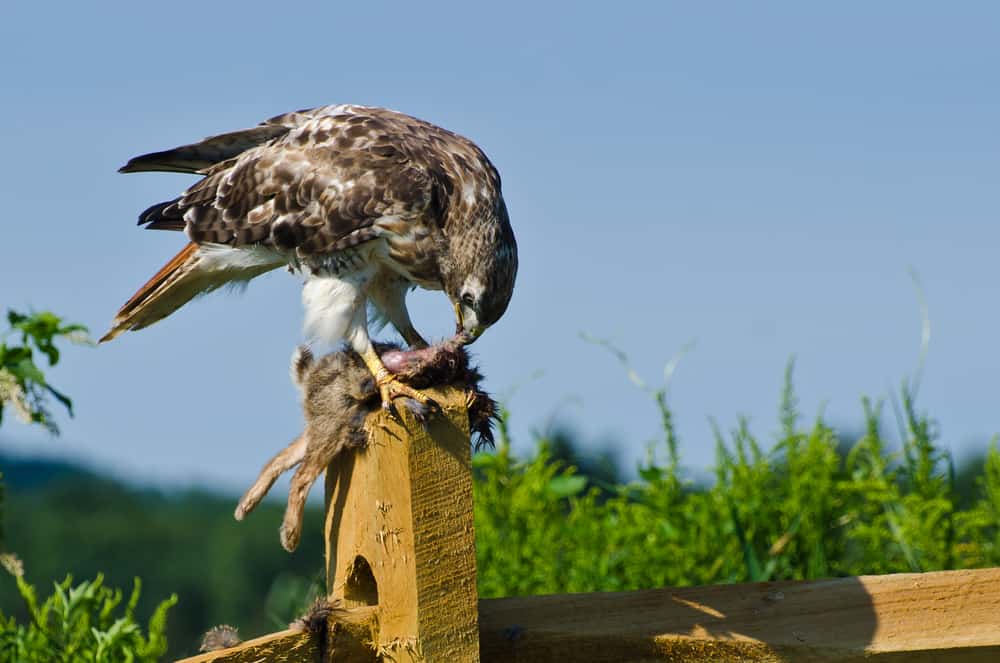Falconry refers to the age-old sport of hunting with raptors. It is time demanding and requires serious commitment. Hawk ownership is nothing like having a hamster or a dog.
You will need to acquire special licensing, adhere to strict environmental conditions, and devote yourself to daily training.
If you are willing to make this commitment, you can begin your two-year journey as an apprentice, provided that you meet all legal and logistical requirements.
Hawks Habits and Biology
A hawk is a member of the family Accipitridae, shared with other predatory birds such as eagles and kites. Hawks are in the same order as falcons, ospreys, and vultures. These birds of prey, all together, are also known as raptors.
Physical Characteristics
- Hawks are diurnal predatory birds with impressively sharp talons (hooked claws), broad wings, hooked beaks, and strong legs and feet.
- The shape and size of hawks vary significantly depending on the environmental conditions to which it has adapted. Usually, these differences reflect its tail shape, plumage, and coloring.
- Typically female hawks will be bigger than their male counterparts, also known as reversed sexual size dimorphism.
- Hawks usually weigh between 4 ounces and 3.25 pounds.
Habitat
- Hawks inhabit every continent except Antarctica. A greater variety of species live in tropical climates, whereas the arctic tundra and desert drylands have not been welcoming enough for these birds of prey.
- Hawks primarily select their living environment based upon the availability of food, risk of predation, and availability of foraging and nesting sites.
- Hawks will migrate for breeding and seasonal purposes.
Behavior
- Usually solitary or semi-colonial.
- Hawks will usually hunt alone, although mates or other close relatives may sometimes hunt together.
Communication/ Perception
- Hawks will use physical cues and vocalization to signal hunger, location, alarm, territorial aggression, and solicit copulation.
- Hawks have eyesight 4 to 8 times better than humans, allowing them to spot prey from long distances.
Reproduction
- Hawks undergo monogamous relationships.
- Male courtship includes foraging for nest material and providing food to its female partner and eyas (baby hawks) up through the nestling stage.
- .Female hawks lay between one to nine eggs per breeding season.
Mortality
- Unfortunately, mortality strikes these fascinating birds prematurely in the form of starvation, siblicide, or predation.
- As these birds grow older, they face illegal poaching, electrocution (cable wires), collisions with a vehicle or wind turbine, and pesticides.
Lifespan
- The average lifespan is just one to two years.
- In the wild, larger species of accipitrids (such as the eagle) have lived up to 38 years of age. However, in captivity, they can live up to 60 years old.
Hawks are amazing predatory birds and have adapted themselves for ultimate hunting prowess in the wild.
Next, I will share what a hawk typically feasts on and briefly discuss the different methods it may employ during its hunt.
What Do Hawks Eat in the Wild
Hawks are opportunists and will gladly feast upon various meal options, including birds, small mammals, fish, and other amphibians,
reptiles and other invertebrates, and even some fruit. For example, watch how this hawk hunts an iguana for her little nestling.
Depending on species and habitat, a general rule of thumb is that these birds must consume between ten and twenty-five percent of their body weight in prey each day.
Hawks use several techniques to secure their calories. Let us discuss each one briefly.
Hunting Techniques
- Perch-hunting- this doubles as the most common technique and the least energy-demanding; its prey remains oblivious to the hawk until it is upon it.
- Hovering and soaring- large-winged accipitrids employ this method to minimize noise and possible detection.
- Ambush hunting- this method entails hiding out stealthily until its prey passes by.
- Active flight- the chase is on…until it’s off.
- Stooping- from a higher altitude, the hawk folds its wings into an aerodynamic missile and plummets toward its prey.
- Cryptic coloration- by imitating plumage colors and flying style, hawks get incredibly close to their prey.
Once capturing its prey, a raptor proceeds to kill it by repeatedly puncturing it with its talons. Then, prey is either swallowed whole or ripped apart with their sharp, hooked beak. Indigestible materials, if swallowed, are regurgitated in a pellet.
I apologize for the mental imagery depicted here; the truth is, raptors leave little to no room for their prey to escape their clutch.
Although a hawk’s diet may change significantly depending on its environment (from tundra to tropical rainforests), it has a good chance of finding something edible.
What Do Hawks Eat As Pets
- As a simple rule, you should feed your hawk an animal or bird that it would otherwise usually capture in the wild.
- Captive-bred food is now readily available including quail, laboratory mice and rats, baby chicks, and rabbits. Be sure to research the food source to ensure that your hawk receives its daily nutritional needs.
- You can supplement your hawk’s diet with fresh food such as plants, fruit, vegetables, and dried nuts.
- Mineral-rich vitamin supplements can be used short-term to replenish your hawk with the appropriate levels of vitamin D, calcium, and phosphorous it needs.
NOTE: Your hawk can fall victim to Stargazing Syndrome if it becomes vitamin D deficient. Without the proper dietary calcium and phosphorous levels, your hawk’s bones may break due to de-ossification.
- Some falconers have used various supplemental methods, including adding honey, aloe vera, cod liver oil, or red palm oil to their hawk’s food.
Remember, there is no better substitute for your hawk’s health than an experienced practitioner.
- Dehydration is a severe threat, so as your hawk’s falconer, you must be sure to provide fresh, clean water. You can do this with a bath pan, through training it to drink from a squirt bottle, or by providing ‘water bombs.’
NOTE: Interesting enough, raptors ingest sufficient water from their food.
- Providing rangle is the practice of carefully selecting and feeding smooth stones to your hawk for gastrointestinal casting- in other words, scraping out the intestinal system from blockages or impurities.
TIP: As a falconer, you pledge to take good care of your hawk. Unfortunately, emergencies do happen, and maybe professional help is too far away. You should always carry an avian first-aid kit, an emergency nutritional recipe for depleted birds, and have some basic first aid knowledge specific to your raptor species.
Tips to Feed Hawks
- It would be best if you offer plenty of nutritional variety in your hawk’s diet.
- Rotate these food sources so that mealtime will always be a pleasant surprise for your trusted companion.
- As a falconer, you should invest in a large, sanitary freezer to stock the game that your hawk catches.
- Be sure that your hawk does not become overweight because this will put undue stress on its ankles and legs, even possibly causing Bumblefoot.
- Help your hawk make minor weight adjustments, when necessary, to prevent overstressing its body and organs.
- Remember that consumption requirements will increase in the winter due to the additional energy required to stabilize their bodies. Conversely, your hawk will consume less in more tropical climates.
- Please do not feed your hawk frozen or hot food; it should be warm to the touch.
- Avoid processed and cooked foods.
- Defrost food quickly to prevent bacterial growth.
- Use frozen game within six months of its catch, so the food does not risk a loss of nutritional value.
- Carefully evaluate your food sources; darker meats are usually more rich and satisfying.
- Egg yolk can be especially beneficial for rehabilitating birds.
In addition to the above feeding tips, you must support your hawk’s home environment. Its mental, emotional, and physical health is just as vital to its well-being as is its nutrition.
- First off, do not attempt to take a nestling from its nest too early; federal and state regulations need to be followed closely for the health of the bird that, you as the falconer, will initially trap in the wild.
- Never place your raptor in a cage; it needs adequate space.
- Challenge your raptor appropriately during training.
- Provide your hawk with sufficient daily exercise to stay in great physical shape.
- Follow your state’s requirements for falconry equipment; this ensures the safety and protection of both you and your hawk.
As an apprentice, you will have to be sponsored by a Master Falconer. Ask lots of questions and take heed to their advice. These men and women have been working with a range of predatory birds for several years, and their experience is priceless.
Additionally, conduct your research on the specific species of bird that you plan to employ as your trusted friend and hunting companion.
Lastly, speak to a trusted veterinarian so that you can establish an emergency plan in the unfortunate event that something should happen to your hawk.
Summary
If you love to work with animals, love the outdoors, and love to hunt, then falconry may be in your calling. However, before you let your excitement overwhelm you, I recommend you take some time to think about what is in the best interest of the bird.
I hope that this article has informed you of some critical features and habits of hawks.
Would you please comment below if you have any questions or concerns about a hawk’s eating habits or falconry?



I’m struggling to find a source for live house sparrows in Chicagoland.
Any advice on any reliable sources?